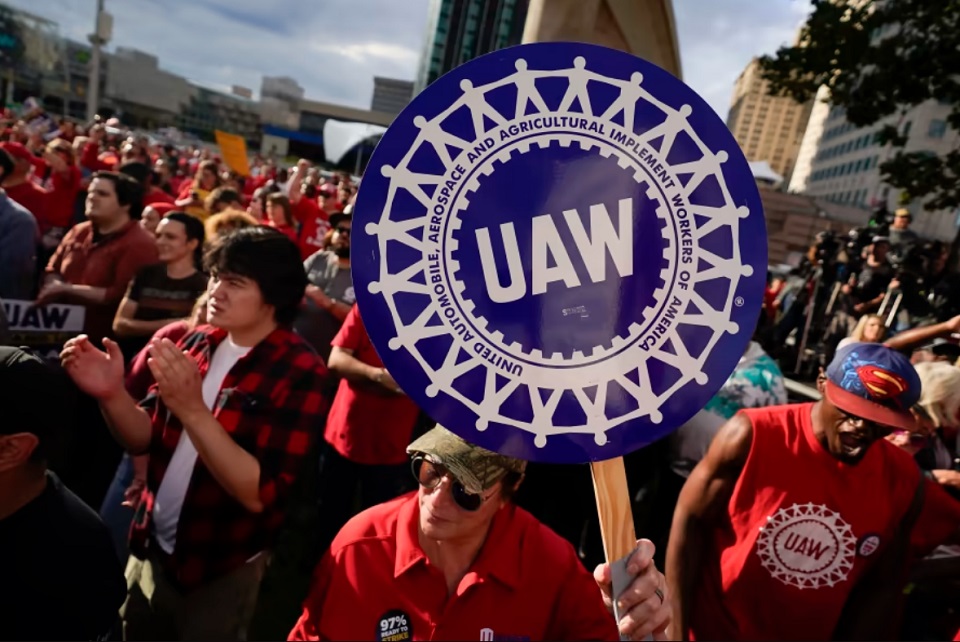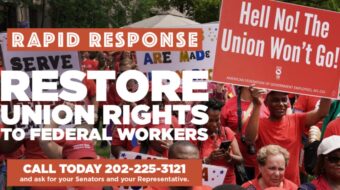
DETROIT–Unionized workers are showing the rest of us that the rich don’t always have to get richer — at everyone else’s expense.
Just hours before the expiration of the United Auto Workers contract with Detroit’s Big Three, UAW President Shawn Fain had plenty on his mind.
Most of that plenty would be obvious and predictable. The impending expiration of his union’s auto industry contract, with no new pact in sight. The state of the union’s readiness for what could be the UAW’s most pivotal strike since 1937. But Fain had something else on his mind as well: The continuing and unforgivable maldistribution of America’s income and wealth.
“Just as in the 1930s,” Fain reminded his fellow Auto Workers, “we’re living in a time of stunning inequality throughout our society.”
Back then, in those 1930s, UAW members began a generation-long struggle that put a significant dent in that “stunning inequality.” By the early 1960s, auto worker struggles and sacrifices had helped give birth—in the United States—to a mass middle class. A majority of a major nation’s households, after paying for life’s most basic necessities, actually had money left over.
In all of world history, that had never before happened.
We have numbers that can help tell this dramatic story. In 1928, just before the Great Depression hit, households in America’s richest 0.1% held a quarter of the nation’s wealth, households in the bottom 90% only just over 15%. By the mid-1970s, that bottom 90% wealth share had more than doubled, to a third of the total.
And the richest 0.1%? The super wealthy’s share of the nation’s wealth had plummeted over those same years from a quarter of America’s treasure to just over 7%.
But then a grand turnaround began. Since 1976, as the economists Thomas Blanchet, Emmanuel Saez, and Gabriel Zucman have detailed, the pretax incomes of America’s top 0.1% have jumped ten times faster than the incomes of working adults in the nation’s middle 40%.
Over those same years, the real incomes of working-age adults in the top 0.01% have soared 856%. The poorest half of the nation’s working adults, in that same 47-year span, have hardly seen any increase at all, with their incomes rising just a minuscule 21%.
Autoworker take-homes have been doing even worse. Their real wages have actually been sinking over recent years. Between 2008 and July 2023, Economic Policy Institute analysts reported, real average hourly earnings for U.S. auto manufacturing workers fell 19.3%.
Top auto industry execs, meanwhile, have been watching their earnings skyrocket. CEO compensation at the auto industry’s Big Three–Ford, General Motors, and Stellantis, the corporate outfit that’s swallowed up Chrysler—has jumped 40% over the past four years, with each of the three CEOs last year taking home at least $21 million. GM’s current chief exec has pocketed over $200 million since 2014.
These same three corporate auto giants, the Economic Policy Institute adds, have “paid out nearly $66 billion in shareholder dividend payments and stock buybacks” over the past decade, not counting the $14 billion in dividends and buybacks shelled out so far this year.
The Big Three’s overall $250 billion in profits since 2013, the EPI goes on to point out, “amounts to nearly $1.7 million for each of the roughly 150,000 workers covered by UAW collective bargaining agreements.”
UAW President Shawn Fain seems to understand, just like his UAW predecessors back in the middle of the 20th century, that any real economic justice for auto workers is always going to demand imaginative struggle on multiple fronts.
Striking UAW workers in 1937 didn’t just walk the picket line. They staged sit-down strikes that captured the imagination of working people the nation over. And that early UAW didn’t just bring imagination to collective bargaining. UAW activists advanced bold egalitarian proposals on other key fronts as well, most strikingly on taxes.
In April 1942, President Franklin Roosevelt proposed a 100% federal income tax rate on income over $25,000, the equivalent of about $470,000 in today’s dollars. Who convinced FDR to push for that income cap? A New York Times report gave that credit to the UAW.
FDR didn’t end up getting Congress to give him a green light on that 100% top tax rate. But by 1944 our nation’s richest would face a 94% tax rate on income over $400,000, and that top rate would hover around 90% for the next two decades, years that would see the distribution of U.S. income and wealth become significantly more equal.
In other words, the rich don’t always have to get richer—at everyone else’s expense.
The distribution of U.S. income and wealth can change, over relatively brief stretches of time and to a consequential extent.
The last time that consequential change took place in the United States, the UAW played a consequential role. That role may now be re-emerging.
>> READ MORE PEOPLE’S WORLD COVERAGE OF THE UAW STRIKE.
We hope you appreciated this article. At People’s World, we believe news and information should be free and accessible to all, but we need your help. Our journalism is free of corporate influence and paywalls because we are totally reader-supported. Only you, our readers and supporters, make this possible. If you enjoy reading People’s World and the stories we bring you, please support our work by donating or becoming a monthly sustainer today. Thank you!










